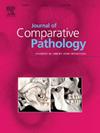Cystic rete testis in a central bearded dragon (Pogona vitticeps)
IF 0.9
4区 农林科学
Q4 PATHOLOGY
引用次数: 0
Abstract
The rete testis forms from the mesonephric tubules in a series of interconnected channels in which spermatozoa travel in a high volume of fluid between the seminiferous tubules and efferent ductules. Cystic rete testis can be identified by uni- or multilocular cysts with a wall lined by low cuboidal epithelial cells and a dense fibrous stroma. An 11-year-old male central bearded dragon (Pogona vitticeps) was evaluated for a coelomic mass. The animal had no other clinical signs apart from coelomic mass effect. Exploratory surgery revealed a mass in the region of the right testis that was excised and submitted for histology. The central bearded dragon had no post-operative clinical abnormalities. Grossly, the 6-cm diameter, smooth, yellow mass was composed of numerous, 0.5–3.0-cm diameter cysts filled with yellow fluid. Histologically, the cysts were lined by simple cuboidal to flattened epithelial cells that rarely formed small tufts or papillary projections. Cyst lumina occasionally connected with seminiferous tubules, approximately 10 % of which were dilated and all of which had normal spermatogenesis. Epithelial cells had a small amount of eosinophilic, slightly vacuolated cytoplasm, rare apical cilia and basilar, round nuclei with coarse chromatin and small, distinct nucleoli. This is the first description of a cystic rete testis in a reptile or any non-mammalian species. Cystic rete testis can be primary or secondary to obstruction of the efferent ductules or epididymis. The lack of inflammation and absence of diffuse dilation of the seminiferous tubules suggest that spermatozoa were able to escape, consistent with primary cystic rete testis.
中央胡须龙的囊性睾丸网。
睾丸网由中肾小管在一系列相互连接的通道中形成,在这些通道中,精子在精管和传出小管之间的大量液体中移动。囊性睾丸网可表现为单室或多室囊肿,其壁由低立方上皮细胞和致密的纤维间质排列。对一只11岁雄性中央胡须龙(Pogona vitticeps)进行体腔肿块评估。除体腔肿块外,无其他临床症状。探查性手术发现右睾丸区域有肿块,已切除并提交组织学检查。中央须龙术后无临床异常。肉眼可见,直径6 cm,光滑的黄色肿块由许多直径0.5 - 3.0 cm的囊肿组成,囊肿内充满黄色液体。组织学上,囊肿由简单的立方到扁平的上皮细胞排列,很少形成小簇状或乳头状突起。囊肿腔偶尔与精小管相连,约10%的精小管扩张,所有精小管的精子发生正常。上皮细胞有少量嗜酸性细胞,细胞质微空泡,很少有根尖纤毛和基底,细胞核圆,染色质粗,核仁小而明显。这是第一次在爬行动物或任何非哺乳动物物种中描述囊性睾丸。囊性睾丸网可原发性或继发于传出小管或附睾梗阻。缺乏炎症和没有弥漫性扩张的精管表明精子能够逃逸,与原发性囊性尿道睾丸一致。
本文章由计算机程序翻译,如有差异,请以英文原文为准。
求助全文
约1分钟内获得全文
求助全文
来源期刊
CiteScore
1.60
自引率
0.00%
发文量
208
审稿时长
50 days
期刊介绍:
The Journal of Comparative Pathology is an International, English language, peer-reviewed journal which publishes full length articles, short papers and review articles of high scientific quality on all aspects of the pathology of the diseases of domesticated and other vertebrate animals.
Articles on human diseases are also included if they present features of special interest when viewed against the general background of vertebrate pathology.

 求助内容:
求助内容: 应助结果提醒方式:
应助结果提醒方式:


